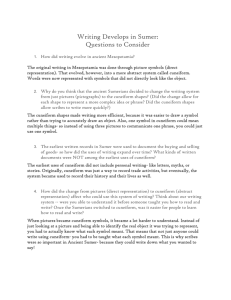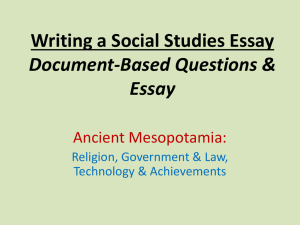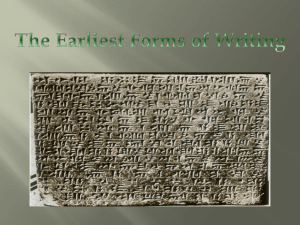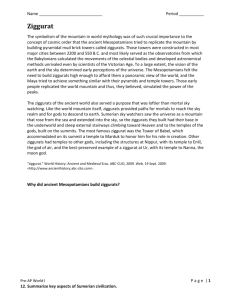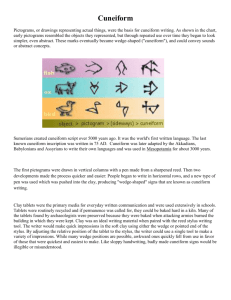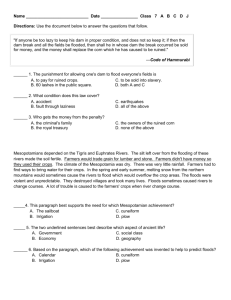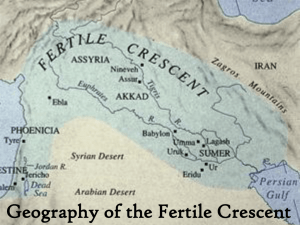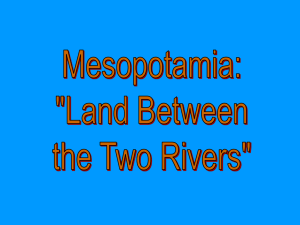Ziggurat
advertisement
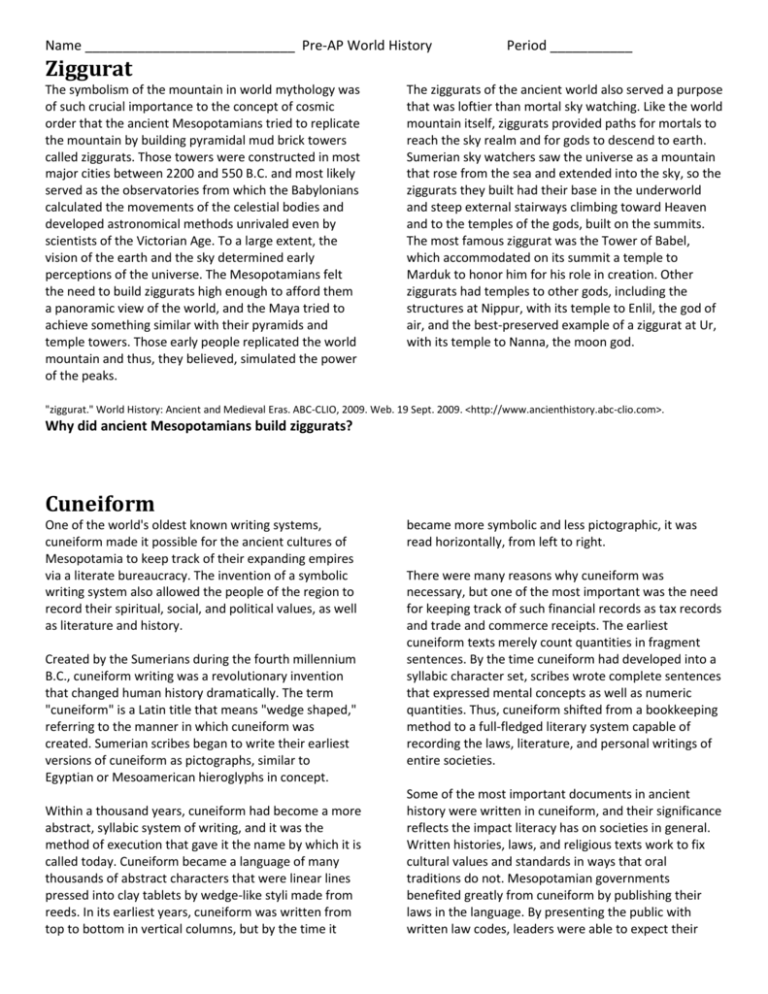
Name ____________________________ Pre-AP World History Period ___________ Ziggurat The symbolism of the mountain in world mythology was of such crucial importance to the concept of cosmic order that the ancient Mesopotamians tried to replicate the mountain by building pyramidal mud brick towers called ziggurats. Those towers were constructed in most major cities between 2200 and 550 B.C. and most likely served as the observatories from which the Babylonians calculated the movements of the celestial bodies and developed astronomical methods unrivaled even by scientists of the Victorian Age. To a large extent, the vision of the earth and the sky determined early perceptions of the universe. The Mesopotamians felt the need to build ziggurats high enough to afford them a panoramic view of the world, and the Maya tried to achieve something similar with their pyramids and temple towers. Those early people replicated the world mountain and thus, they believed, simulated the power of the peaks. The ziggurats of the ancient world also served a purpose that was loftier than mortal sky watching. Like the world mountain itself, ziggurats provided paths for mortals to reach the sky realm and for gods to descend to earth. Sumerian sky watchers saw the universe as a mountain that rose from the sea and extended into the sky, so the ziggurats they built had their base in the underworld and steep external stairways climbing toward Heaven and to the temples of the gods, built on the summits. The most famous ziggurat was the Tower of Babel, which accommodated on its summit a temple to Marduk to honor him for his role in creation. Other ziggurats had temples to other gods, including the structures at Nippur, with its temple to Enlil, the god of air, and the best-preserved example of a ziggurat at Ur, with its temple to Nanna, the moon god. "ziggurat." World History: Ancient and Medieval Eras. ABC-CLIO, 2009. Web. 19 Sept. 2009. <http://www.ancienthistory.abc-clio.com>. Why did ancient Mesopotamians build ziggurats? Cuneiform One of the world's oldest known writing systems, cuneiform made it possible for the ancient cultures of Mesopotamia to keep track of their expanding empires via a literate bureaucracy. The invention of a symbolic writing system also allowed the people of the region to record their spiritual, social, and political values, as well as literature and history. Created by the Sumerians during the fourth millennium B.C., cuneiform writing was a revolutionary invention that changed human history dramatically. The term "cuneiform" is a Latin title that means "wedge shaped," referring to the manner in which cuneiform was created. Sumerian scribes began to write their earliest versions of cuneiform as pictographs, similar to Egyptian or Mesoamerican hieroglyphs in concept. Within a thousand years, cuneiform had become a more abstract, syllabic system of writing, and it was the method of execution that gave it the name by which it is called today. Cuneiform became a language of many thousands of abstract characters that were linear lines pressed into clay tablets by wedge-like styli made from reeds. In its earliest years, cuneiform was written from top to bottom in vertical columns, but by the time it became more symbolic and less pictographic, it was read horizontally, from left to right. There were many reasons why cuneiform was necessary, but one of the most important was the need for keeping track of such financial records as tax records and trade and commerce receipts. The earliest cuneiform texts merely count quantities in fragment sentences. By the time cuneiform had developed into a syllabic character set, scribes wrote complete sentences that expressed mental concepts as well as numeric quantities. Thus, cuneiform shifted from a bookkeeping method to a full-fledged literary system capable of recording the laws, literature, and personal writings of entire societies. Some of the most important documents in ancient history were written in cuneiform, and their significance reflects the impact literacy has on societies in general. Written histories, laws, and religious texts work to fix cultural values and standards in ways that oral traditions do not. Mesopotamian governments benefited greatly from cuneiform by publishing their laws in the language. By presenting the public with written law codes, leaders were able to expect their citizens to actually abide by the rules; citizens could not claim ignorance of the laws. As a result, laws were codified using cuneiform throughout the region. Cuneiform also made it possible for Mesopotamian cultures to record their myths, legends, and religious values. Theologians wrote histories and genealogies of the gods, compendiums for reading omens, and guidebooks for temple worship. Epic poems were also created, detailing the lives of the gods and events of supernatural phenomena. One of the most important literary works is the Epic of Gilgamesh, a Babylonian tale that tells of a heroic figure who sets out to face the gods. Those texts served not only to educate and entertain, but to disseminate religious faith. Because of the fixed nature of texts, they also worked to solidify beliefs that may have been more malleable had they only passed through oral traditions. Finally, one of the most important innovations of cuneiform writing was that it allowed individuals to write letters and other ego-documents that historians can use for a glimpse into their inner lives. There are hundreds of thousands of such documents that have been discovered so far. Taken together with the bureaucratic, legal, and religious texts of the Mesopotamians, they give historians a deeper understanding of the readers and writers of cuneiform, far more complete than many other ancient societies that existed without literary documents. As one of the oldest forms of writing known to humanity, cuneiform had an immeasurable impact on societies in Mesopotamia. Utilized in one form or another from the fourth millennium B.C. until the first century A.D., cuneiform gave written expression to millions of people in many different societies and empires. By streamlining written expression from pictographs to abstract syllabic codes, the creators of cuneiform made it possible for Mesopotamian peoples to keep effective business records, maintain massive government bureaucracies, codify their legal systems, and express their artistic and religious ideas. It also allowed people to correspond with loved ones in letters or even to write grocery lists. In doing so, it fixed many aspects of Mesopotamian culture that may have been more fluid if existing only within the confines of oral tradition. "cuneiform." World History: Ancient and Medieval Eras. ABC-CLIO, 2009. Web. 19 Sept. 2009. <http://www.ancienthistory.abcclio.com>. What is cuneiform? Why was a written language necessary? Page |2

